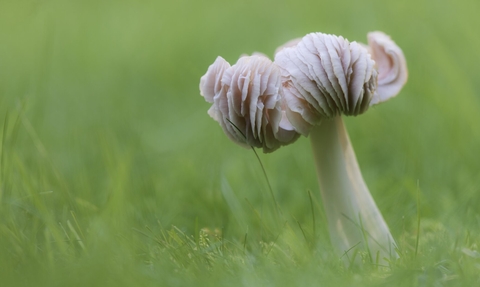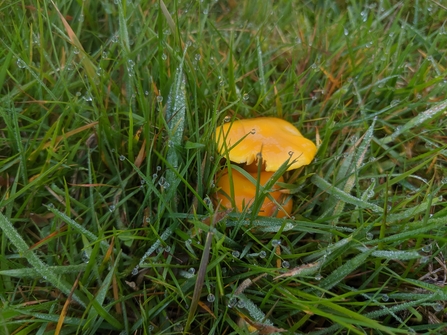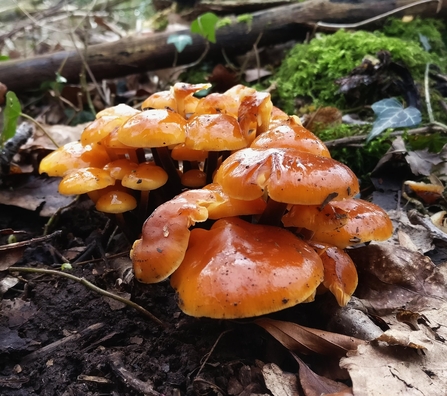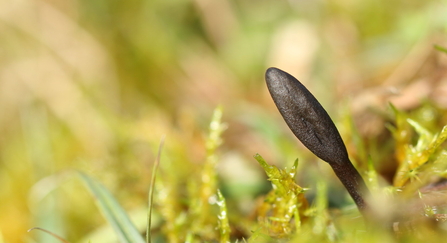
Pink Waxcap (Hygrocybe calyptriformis) (c) Guy Edwardes/2020VISION
Where to see waxcaps and grassland fungi
Brightly coloured waxcaps are a group of fungi that take their name from the waxy texture of their caps. There are about 40 species of waxcap in the UK, home to half the world’s population of waxcap species. Though not rare, they are an indication of unimproved grassland of which there’s little left in the Herefordshire so seeing them is quite a treat. Waxcaps are often found with other indicator species of fungi, belonging to the entolomas (pinkgills), coral, club and earthtongue groups.
Sturts North
For waxcap enthusiasts, The Sturts North near Letton is a must. Home to 28 species of waxcaps, this reserve is a nationally important site for this fungus. Early November is the best time to visit for waxcaps, perhaps the easiest to spot are the brightly coloured pink waxcap (Porpolomopsis calyptriformis) and scarlet waxcap (Hygrocybe coccinea) seen doted around the reserve, along with the elegant snowy waxcap (Cuphophyllus virgineus).
The seven fields that make up Sturts North are subject to regular winter flooding. If the A438 is closed at Letton, chances are the Sturts will be flood so it’s worth checking before you go.

Golden waxcap (c) Vaughn Matthews
White Rocks
In the south of the county, White Rocks on the Doward is an ancient broad-leaved woodland with limestone grassland and here in the grassland a variety of colourful waxcap fruiting bodies appear in the autumn. Their waxy caps can become sticky almost slimy when wet. As a bonus, alongside the waxcaps are weird and wonderful fungi - earthstars and earthtongues (Geoglossum fallax). Earthstars have a distinctive star-like appearance around a central puffball while earth tongues are a blackened club-shaped structure that’s flattened and sometimes grooved, resembling a tongue!.

Waxcap at White Rocks
Birches Farm
Birches Farm is a rarity. Thanks to the centuries of protection from the deep plough and modern fertilisers, the patchwork of meadows and pastures that make up Birches Farm provide the ideal environment for wildlife to flourish. Testament to the unimproved nature of the grassland is the presence of a host of different waxcaps in the autumn, especially on the permanent pasture fields, with poorer soils.

Fibrous waxcap (c) Sarah Cadwallader
The Parks
For some, the most beautiful of the waxcaps is the pink waxcap that can be seen at The Parks nature reserve near Ewyas Harold. You can spot them about during October/November, sometimes in small scattered clusters but often alone. Pink waxcaps have a domed, pale pink cap on a white stalk. As they age, the cap often splits and turn into a distinctive upwards shape, hence it’s other common name, the ballerina waxcap.

Pink Waxcap (Hygrocybe calyptriformis) (c) Guy Edwardes/2020VISION
Pages Pasture
Survey work carried out 8 years ago, identified Pages Pasture near Bromyard as a good site for waxcaps and entolomas, with it almost meeting the criteria for being designated as a SSSI for this feature. Species recorded included the wonderfully named splendid waxcap (Hygrocybe splendidissima), star pinkgill (Entoloma conferendum) and more common earthtongue, Geoglossum cookieanum. The splendid waxcap has a conical scarlet cap which flattens with age but is often confused with the Crimson Waxcap (Hygrocybe punicea) when young – to distinguish between the two, the splendid waxcap has dry or only slightly greasy cap. The brown capped Star Pinkgills fruit from spring right through to the onset of winter. The spores, which tend to be irregularly star shaped, give this neat little pinkgill mushroom its common name.

Earthtongue (c) Vaughn Matthews
